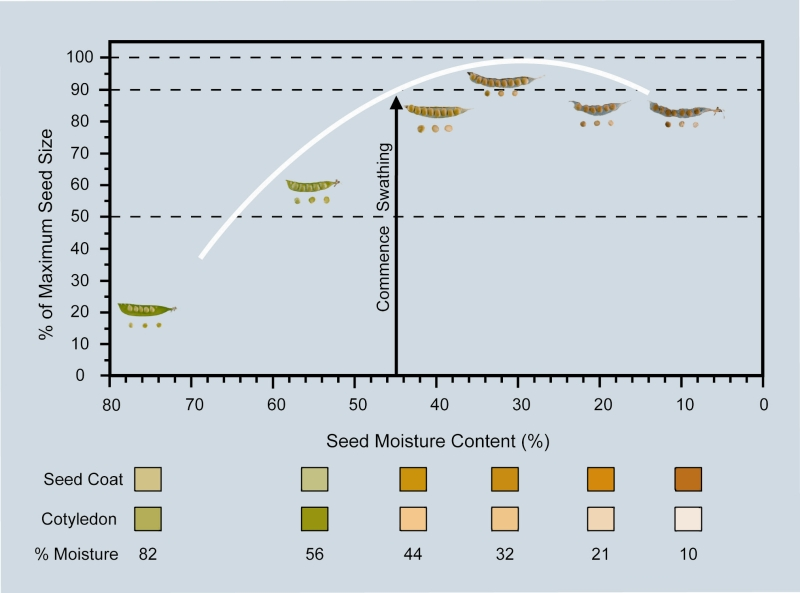In recent years, semi-leafless varieties with the sugar pod trait (for example, Kaspa and Moonlight) have been found to be well suited to swathing. The swaths are much more stable than conventional trailing types (for example, Dundale and Parafield) as the tendrils lock together and the sugar pod trait reduces pod shatter or pod loss. Semi-leafless lines that do not have the sugar pod trait, such as Excell and Snowpeak, are less suited to swathing, particularly at more mature stages, as they are more likely to shed seed.
In general, swathing conventional trailing peas (Dundale, Parafield etcetera) is not recommended as the swath is susceptible to being disturbed by the wind. Heavy swaths formed by windrowing conventional trailing peas with an expected yield of at least 1.5 tonnes per hectare (t/ha) are less likely to be disturbed by strong wind events.
Benefits of swathing:
- improves quality of harvested grain
- reduces soil contamination of grain due to reduced lodging, less earth tag (soil that sticks to pods and stems), with dirt or stones picked up often falling out of the swath
- reduces harvester maintenance costs
- rocks and roots often fall out of the swath, or if observed can be manually removed
- less earth tag reduces wear rates
- increases the time available for harvesting of field pea
- field pea can be swathed before they are ready to be direct harvested
- field pea can be swathed when all crops are too wet to direct harvest
- swaths can be picked up at any time – day or night
- swathing may reduce seed set of weeds.
Disadvantages of swathing:
- swathing is another operation and cost
- in wet conditions, both seed quality and yield may be at risk due to the swaths retaining moisture. In Canada, where the swathing of field pea and wet harvests are more common, growers resort to turning over damp field pea swaths in order to maintain seed quality
- crop-topping may be compromised because the timing of swathing and croptopping may not coincide.
Timing of swathing
When to start swathing
Snowball (1986) conducted a number of experiments on field pea swathing in the 1980s from which guidelines for the timing of swathing were established. Field pea can be successfully swathed from when 50% of the crop is still green or yellow and 50% of crop is brown.

This often equates to an average seed moisture content (SMC) of 40-45%, with 60% of seed still large and moist and the remaining 40% of seed small and dry (SMC less than 25%) – see Figure 1 and Table 1.

| Seed size | Cotyledon colour of Kaspa | Seed moisture content (SMC %) | Comment |
|---|---|---|---|
| Large | Green  | Greater than 50 | Seeds in pods squash easily |
| Large | Yellow
| 40-50 | Time to start swathing |
| Large | Yellow
| 25-40 | Rapid drying |
| Small | Beige
| 12-25 | Seeds difficult to dent with thumbnail |
| Small | Pale pink
| Less than 12 | Seeds are hard |
If the crop is swathed too early, seeds will not fill properly and yield may be lost. Swathing too early may also increase the proportion of green cotyledons which can cause problems at delivery as milling peas cannot have more than 1% of poor coloured seed. If swathing is delayed until full maturity there is a greater risk of pod-shattering particularly in those varieties without the sugar pod trait.
The suggested time to commence swathing, 50% maturity (average SMC of 40-45%), is earlier than the 75% maturity (average SMC less than 30%) suggested for croptopping field pea. Growers must therefore assess the cost of a reduced field pea yield with the benefits of reducing weed seed set. To minimise yield loss, growers committed to reducing weed seed set by croptopping should use glyphosate, rather than diquat or paraquat. Alternatively, growers may choose to wait until the crop is at 75% maturity before croptopping and swathing. Swathing itself may reduce the seed set of weeds depending on the species of weed and the growth stage of the weed when it is swathed. In many instances, growers will need to use follow up non selective sprays over the paddock to stop regrowth or to minimise the seed set of weeds particularly if the heads of the weeds are below the swathing height.
When to stop swathing
Semi-leafless field pea varieties which possess the sugar pod trait such as Kaspa and Moonlight may be successfully swathed at later stages (75-100%) of maturity. Field pea varieties that do not possess the sugar pod trait may experience significant shattering if swathed at later stages of maturity. Growers have successfully swathed mature crops directly in front of the harvester under cool and damp conditions. If shattering becomes excessive whilst swathing, then cease operations and direct harvest the crop. Alternatively, stop swathing and return when conditions are cooler.




